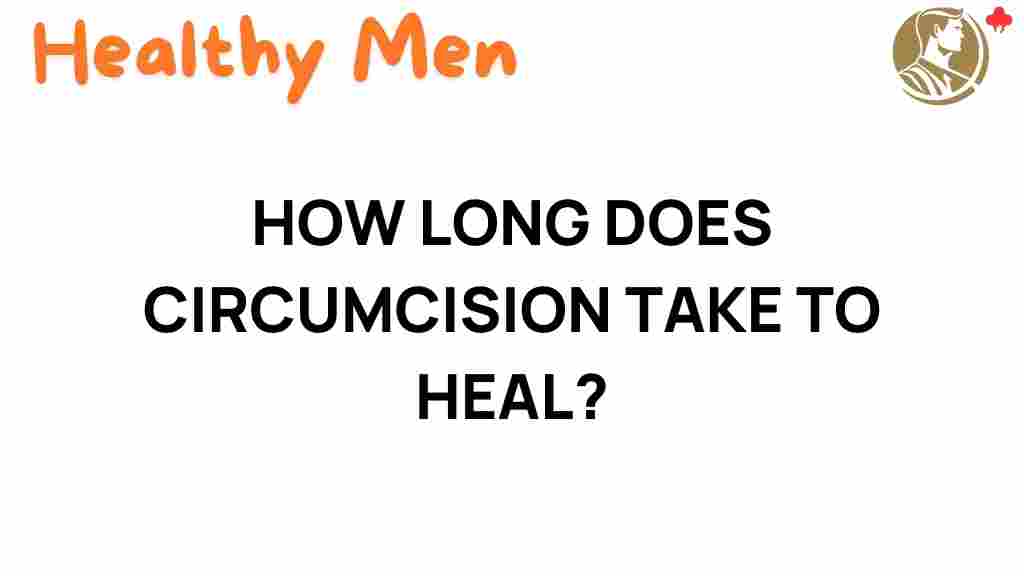Healing Unveiled: How Long Does Circumcision Truly Take?
Circumcision is a common surgical procedure performed on newborns, infants, and older children for various reasons, including religious, cultural, and medical. However, one of the most frequently asked questions surrounding this procedure is: how long does circumcision healing take? Understanding the healing time and the factors involved in recovery is crucial for parents and caregivers. In this article, we will explore the timeline of recovery, effective post-operative care, potential complications, and essential tips for ensuring a smooth healing process.
The Circumcision Procedure
Circumcision involves the surgical removal of the foreskin from the penis. This procedure can be performed in a hospital or clinic setting and is typically quick, often completed within 30 minutes. The type of circumcision performed and the age of the child can influence the healing time.
Understanding the Healing Timeline
The healing time after circumcision varies based on several factors, including the age of the patient and the surgical technique used. Here’s a general timeline of recovery:
- First 24 Hours: After the procedure, the infant may experience some swelling, redness, and discomfort. Pain relief medications may be prescribed.
- Days 2-3: Swelling may peak during this time. It’s essential to keep the area clean to prevent infection.
- Week 1: Most infants will start to feel better and can resume normal activities. The surgical site should begin to heal, and some yellowish crust may form.
- Week 2: By the end of the second week, the majority of the healing should be complete, although the area may still be sensitive.
- Weeks 3-4: Full recovery typically occurs within 4 to 6 weeks, but the circumcision site may continue to improve in appearance over time.
Post-Operative Care for Infants
Proper post-operative care is crucial for minimizing complications and ensuring a smooth recovery. Here are some essential care tips:
- Keep it clean: Gently clean the area with warm water during baths. Avoid using soaps or lotions directly on the site until it is healed.
- Monitor for signs of infection: Redness, excessive swelling, or discharge may signal an infection. Consult a healthcare professional if these symptoms occur.
- Pain management: Use acetaminophen or ibuprofen as directed by your doctor to manage pain.
- Dressings: If a dressing was applied, follow your doctor’s instructions on when to remove it. Typically, it can be removed after 24 hours, but always consult your pediatrician.
- Diaper changes: Change diapers frequently to prevent the area from becoming moist and irritated.
Potential Complications
While circumcision is generally considered safe, there are potential complications that parents should be aware of:
- Infection: As with any surgical procedure, there is a risk of infection. Ensure proper hygiene to minimize this risk.
- Excessive bleeding: This can occur if blood vessels are not properly sealed during the procedure.
- Meatal stenosis: This condition occurs when the opening of the urethra narrows, which may require additional treatment.
- Scarring: In some cases, improper healing can lead to scarring or cosmetic concerns.
Infant Care During Recovery
Infant care during the recovery period is crucial for ensuring a smooth healing process. Here are some tips:
- Comfort: Offer comfort to your infant by holding them and providing a soothing environment.
- Feeding: Maintain regular feeding schedules. If breastfeeding, ensure the infant is latching properly to avoid discomfort.
- Monitor behavior: Keep an eye on your infant’s behavior. If they seem excessively irritable or in pain, consult your healthcare provider.
Troubleshooting Common Issues
During the recovery period, parents may encounter some common issues. Here’s how to troubleshoot:
- If your infant has a fever: A mild fever is common, but if it exceeds 100.4°F (38°C) or persists, contact a healthcare professional.
- If there’s excessive bleeding: Apply gentle pressure to the area and consult your doctor immediately if bleeding does not stop.
- If there are signs of infection: Seek medical attention if you notice increased redness, swelling, or discharge.
Long-Term Care and Health Considerations
After the initial healing period, long-term care is essential for your child’s health. Consider the following:
- Regular check-ups: Schedule regular pediatric appointments to monitor your child’s health and development.
- Education: As your child grows, educate them about their body and hygiene practices.
- Consultation for complications: If any complications arise, such as meatal stenosis or abnormal scarring, consult a specialist for further evaluation.
Conclusion
Understanding the healing time and recovery process after circumcision is crucial for parents and caregivers. While the procedure is generally safe, proper post-operative care and awareness of potential complications can significantly impact the healing process. By following the guidelines outlined in this article, parents can help ensure a smooth recovery for their child.
For more information on circumcision and related health topics, visit Healthline. If you have specific questions or concerns, always consult your pediatrician or a healthcare professional.
This article is in the category Conditions and created by healthymen Team
